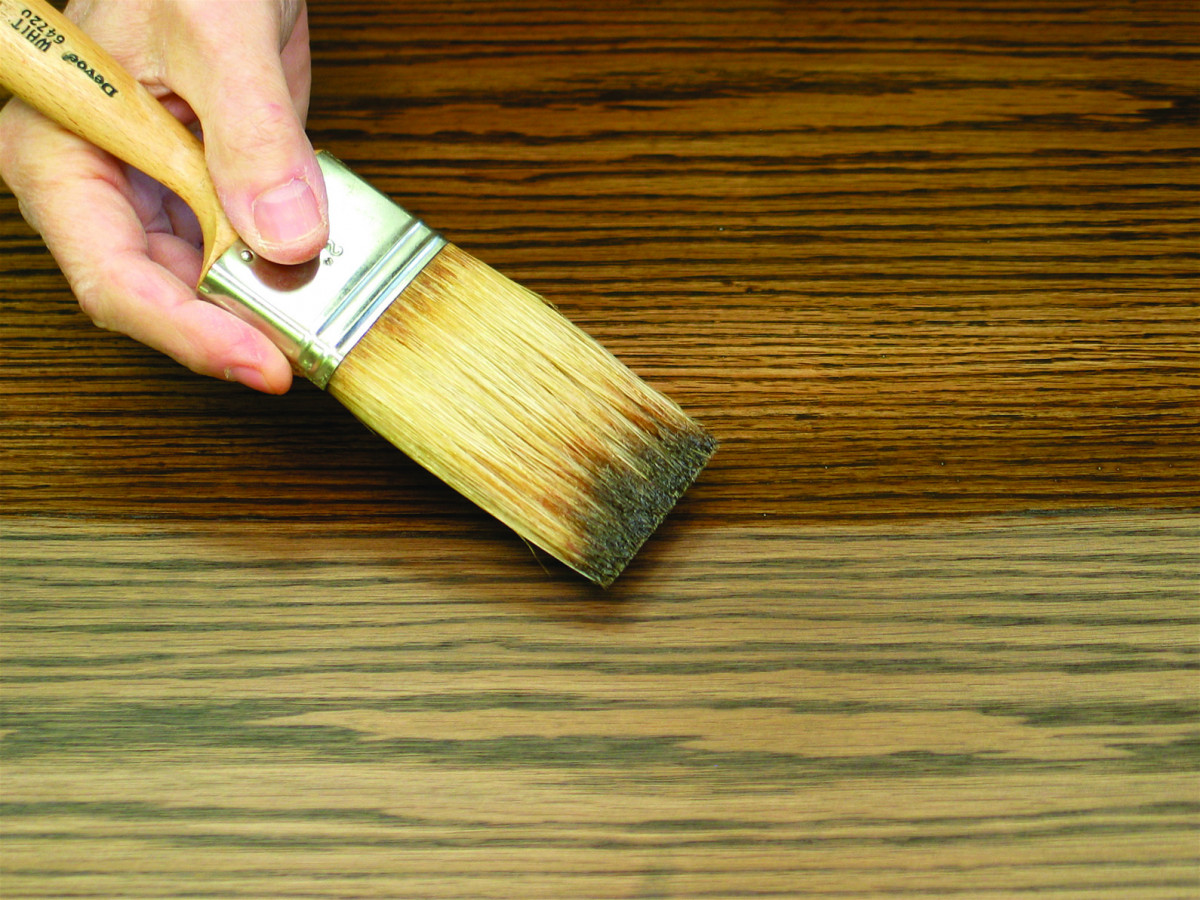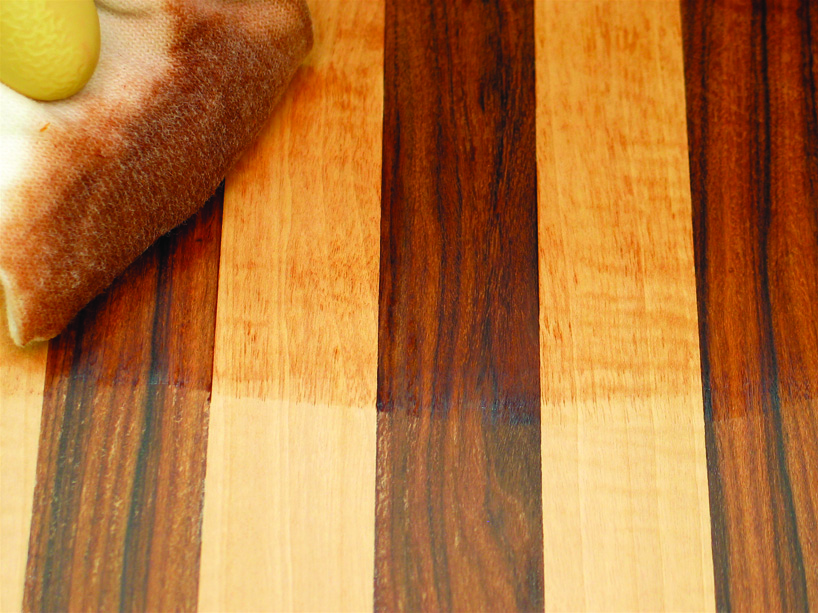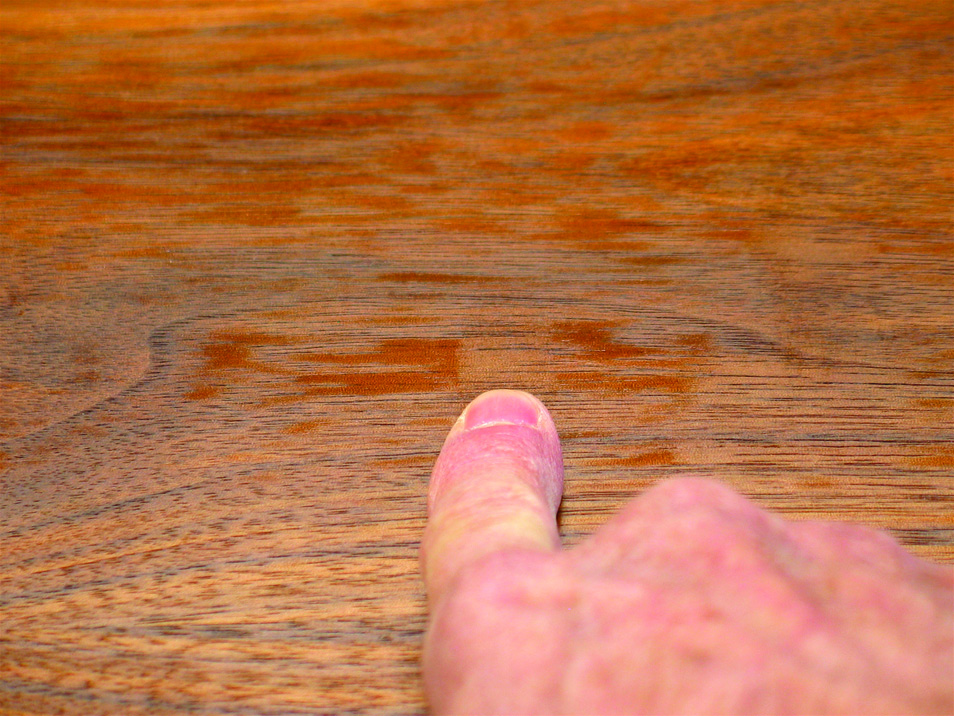We may receive a commission when you use our affiliate links. However, this does not impact our recommendations.

Too cold. If your varnish brush is picking up some of the stain color as shown here, the most likely cause is cool temperatures in your shop. I let this oil stain dry 24 hours in a shop at about 55°, clearly not long enough at this temperature.
Why stains and finishes sometimes dry slowly.
A friend called with a problem. He had applied an ebony oil stain to oak and after the stain had dried for two days, the polyurethane he then brushed picked up some of the color and smeared it around the surface.
Was there a problem with the stain, or did he do something wrong?
Well, I could think of several possible problems with the stain. First, a very dark stain requires more pigment. So maybe the manufacturer just hadn’t added enough binder (oil or varnish) to encase all the pigment well. Second, some manufacturers are replacing solvent with slow-drying oils to comply with California VOC rules and then selling this product to the entire country to avoid having to make two lines. Oils dry slower.
But my first thought was the weather. Though it had been mild lately, with highs in the 60s and lows in the 40s and 50s, that’s still too cool for normal drying. Most stains and finishes need at least 65° to 70° temperatures for eight hours or more to dry at a normal rate. (Exceptions are water-based stains and finishes, which are affected more by humidity than temperature; and lacquers, which can be made to dry normally in cold weather by adding acetone or fast-evaporating lacquer thinners available from auto-body supply stores.)
So I asked about the shop temperature while the stain was drying. My friend assured me he had heat, but on further questioning he revealed that he turned it off at night.
After trying the stain myself in my warm shop, I concluded the problem was lack of adequate heat. This is usually the cause of stains and finishes drying slowly, and it is the first thing you should think of when faced with a drying problem.
If you can’t avoid a cold shop you could bring the project inside your house after each coat, or you could keep the finish warm with a heat lamp or even a blow dryer for small objects. Alternatively, you’re just going to have to give each coat longer to dry.
Temperature isn’t the only cause of slow drying. Others include:
• Applying oil or varnish onto oily woods;
• Not wiping off all excess oil finish; and
• Using shellac that is too old.
Oily Woods

Oily woods. The oily resin in some woods slows the drying of oil and varnish finishes, so you should remove this resin before applying either finish. Acetone is the most effective solvent for removal, but it can lift some of the color and smear it over other woods if you are using several hardwood species together, as I’m doing here. Mineral spirits and naphtha won’t do this, but they are less effective at removing the oily resin.
Most exotic woods, such as teak, rosewood, cocobolo and ebony, contain natural resins that feel and act like oil. These resins retard the drying of oils and varnishes (and also oil stains).
This is counter-intuitive – so much so that it’s common to see instructions in woodworking magazines calling specifically for the use of oil or varnish on oily woods because these finishes are “compatible.” The opposite is the case. Oils and varnishes are the only finishes that don’t dry well.
The explanation is this: The non-drying oily resins on the wood’s surface mix into the wet oil or varnish finish and keep the finish molecules apart so they don’t bump into each other and crosslink. The resins act like paint thinner that doesn’t evaporate.
Once you have applied an oil or varnish to an oily wood and discovered the finish isn’t drying, there are only two good fixes: apply heat to the surface to excite the molecules so they are more likely to bump into each other and crosslink, or strip the finish and start over. It’s usually quite easy to strip (actually just wash off) an oil or varnish that hasn’t dried using naphtha or lacquer thinner. Sometimes mineral spirits is strong enough.
To prevent a drying problem before it happens (or after you have stripped a non-drying finish), remove the oil from the surface of the wood or seal the wood with shellac.

Sticky oil. You should always wipe off all oil finish from the wood after each coat. If you leave the wood a little damp, as I’ve done here, the finish won’t dry well. It will remain sticky for days, or longer.
To remove the oil, wipe with one of several solvents: mineral spirits, naphtha, alcohol, acetone or lacquer thinner. Mineral spirits and naphtha are the least effective, but they don’t lift and smear the color of the wood. Each of the other solvents could remove some of the color along with the oily resin.
So if you have joined two or more woods, as in a cutting board or segmented bowl, try mineral spirits or naphtha first. Check that the colors don’t smear on scrap wood before using one of the other solvents.
Whichever solvent you use, wet the wood well with one rag then dry the wood with another so you remove the oil, not just smear it around. Apply the new finish right after the solvent evaporates so there’s not time for the oily resin in the wood to rise back to the surface.
Alternatively, you can seal the wood with another finish before applying the oil or varnish. Shellac is the most effective at blocking off the oil.
Oil Finish

Undissolved shellac. Bleached shellac loses its ability to dissolve after a few years. If the shellac looks like this, even after overnight in alcohol, it is no good and should be thrown away. The “blocked” flakes to the left of the jar are a good indication that the shellac may not dissolve.
The common instruction for applying oil and oil/varnish-blend finishes is to wet the surface well and then wipe off the excess after the finish has had a few minutes to soak in. This instruction is vague because different interpretations can be given to “wipe off the excess.”
What is meant is ALL of the excess. The surface should not be left damp to the touch. Oil doesn’t dry well, so leaving even a very thin film of damp finish (anything that wets your fingers or feels sticky) will result in a sticky surface for a long time.
If you have a situation where you didn’t remove enough of the oil and it’s now too sticky to remove with a dry cloth, follow the instructions above for dealing with an oil or varnish that won’t dry on an oily wood.
Shellac

Slow drying shellac. Dissolved shellac deteriorates as it ages so that it dries slower and loses its water resistance. This is the reason you should use shellac as freshly dissolved in alcohol as possible. Here, my finger still leaves a mark in the shellac after overnight drying. The shellac was five years old.
Shellac deteriorates much more rapidly than other finishes. The deterioration leads to slower drying and reduced water resistance.
In solid flake form, bleached or “blonde” shellac deteriorates much faster than non-bleached, sometimes within a year or two (non-bleached remains good for many years). The variables are the methods used to bleach the shellac and the temperature in which the shellac is stored, with higher temperatures leading to faster deterioration.
You can slow the deterioration by storing the shellac in a refrigerator.
Once the shellac is dissolved in alcohol, all types of shellac deteriorate, again with this occurring faster the higher the temperatures in which the shellac is stored. You should use the shellac within a year of its having been dissolved in alcohol if you are using it as a finish and not just as a sealer under another finish.
For any critical project, such as a tabletop, you should dissolve your own flakes and use the shellac as quickly as possible – within several weeks or months.
Other finishes also deteriorate, of course, but the deterioration doesn’t lead to significantly slower drying. Pre-catalyzed lacquer loses some of its durability after a few years (the time varies with different manufacturers), and water-based finishes sometimes curdle after a number of years. I’ve never seen varnish or lacquer deteriorate as long as air is kept out of the can, no matter how old.
Here are some supplies and tools we find essential in our everyday work around the shop. We may receive a commission from sales referred by our links; however, we have carefully selected these products for their usefulness and quality.







